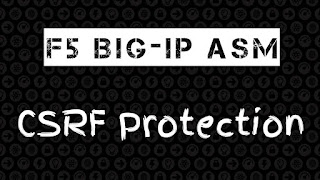F5 BIG-IP ASM - CSRF Protection
I think,
the best way to learn about hacking and security is testing attacks
and mitigating them. This is the methodology I follow in the Security
courses on Networks and Systems
I’m teaching these weeks. In addition, I like testing the
laboratories before teaching to students because there are lots of
kind of attacks and I think the best way to learn about how to block
them is testing, testing and testing. Today, I’m going to write
about how to exploit a CSRF vulnerability and how to mitigate it with
a Web
Application Firewall (WAF).
If you
really want to learn about hacking and security, firstly, you have to
deploy a laboratory with lots of technologies, such as IDS, HIDS,
WIDS, network firewalls, WAFs, SIEMs; vulnerable servers like
WebGoat;
and hacking tools such as those which come with the Kali Linux
operating system. Secondly, you must have lots of time to read and
test because most the time you’ll have to learn by yourself.
Finally, you should really love security. Today, I’ve used a Kali
Linux with WebGoat as vulnerable server and a F5 BIG-IP ASM as WAF.
 |
| WebGoat |
The Proof
of Concept (PoC) that I have been testing today is a CSRF attack
which is used when a malicious user wants to execute unauthorized
commands from a user that the web application trusts. For instance,
firstly, the victim has authenticated into the target website, such
as a bank account website or a forum; secondly, the attacker sends a
malicious link to fool victim to click; finally, if the victim clicks
the malicious link, unauthorized commands are executed, such as
transfers in the bank account or replies in the forum, which have
happened underground. It’s important to highlight that XSS attacks
exploit the trust a user has for a particular site while CSRF attacks
exploit the trust a site has in a user’s browser.
 |
| CSRF Attack |
If you
want to know how to test and mitigate a CSRF attack, see the next
video:
Regards
my friend and remember, keep
studying!!










Commentaires
Enregistrer un commentaire